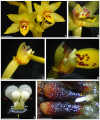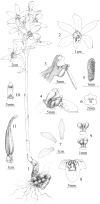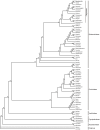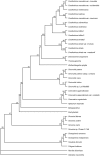A new orchid genus, Danxiaorchis, and phylogenetic analysis of the tribe Calypsoeae
- PMID: 23593204
- PMCID: PMC3617198
- DOI: 10.1371/journal.pone.0060371
A new orchid genus, Danxiaorchis, and phylogenetic analysis of the tribe Calypsoeae
Abstract
Background: Orchids have numerous species, and their speciation rates are presumed to be exceptionally high, suggesting that orchids are continuously and actively evolving. The wide diversity of orchids has attracted the interest of evolutionary biologists. In this study, a new orchid was discovered on Danxia Mountain in Guangdong, China. However, the phylogenetic clarification of this new orchid requires further molecular, morphological, and phytogeographic analyses.
Methodology/principal findings: A new orchid possesses a labellum with a large Y-shaped callus and two sacs at the base, and cylindrical, fleshy seeds, which make it distinct from all known orchid genera. Phylogenetic methods were applied to a matrix of morphological and molecular characters based on the fragments of the nuclear internal transcribed spacer, chloroplast matK, and rbcL genes of Orchidaceae (74 genera) and Calypsoeae (13 genera). The strict consensus Bayesian inference phylogram strongly supports the division of the Calypsoeae alliance (not including Dactylostalix and Ephippianthus) into seven clades with 11 genera. The sequence data of each species and the morphological characters of each genus were combined into a single dataset. The inferred Bayesian phylogram supports the division of the 13 genera of Calypsoeae into four clades with 13 subclades (genera). Based on the results of our phylogenetic analyses, Calypsoeae, under which the new orchid is classified, represents an independent lineage in the Epidendroideae subfamily.
Conclusions: Analyses of the combined datasets using Bayesian methods revealed strong evidence that Calypsoeae is a monophyletic tribe consisting of eight well-supported clades with 13 subclades (genera), which are all in agreement with the phytogeography of Calypsoeae. The Danxia orchid represents an independent lineage under the tribe Calypsoeae of the subfamily Epidendroideae. This lineage should be treated as a new genus, which we have named Danxiaorchis, that is parallel to Yoania. Both genera are placed under the subtribe Yoaniinae.
Conflict of interest statement
Figures





Similar articles
-
A new myco-heterotrophic genus, Yunorchis, and the molecular phylogenetic relationships of the tribe Calypsoeae (Epidendroideae, Orchidaceae) inferred from plastid and nuclear DNA sequences.PLoS One. 2015 Apr 22;10(4):e0123382. doi: 10.1371/journal.pone.0123382. eCollection 2015. PLoS One. 2015. PMID: 25902264 Free PMC article.
-
Thuniopsis: A New Orchid Genus and Phylogeny of the Tribe Arethuseae (Orchidaceae).PLoS One. 2015 Aug 5;10(8):e0132777. doi: 10.1371/journal.pone.0132777. eCollection 2015. PLoS One. 2015. PMID: 26244769 Free PMC article.
-
Paraholcoglossum and Tsiorchis, two new orchid genera established by molecular and morphological analyses of the Holcoglossum alliance.PLoS One. 2011;6(10):e24864. doi: 10.1371/journal.pone.0024864. Epub 2011 Oct 10. PLoS One. 2011. PMID: 22016762 Free PMC article.
-
Roles of synorganisation, zygomorphy and heterotopy in floral evolution: the gynostemium and labellum of orchids and other lilioid monocots.Biol Rev Camb Philos Soc. 2002 Aug;77(3):403-41. doi: 10.1017/s1464793102005936. Biol Rev Camb Philos Soc. 2002. PMID: 12227521 Review.
-
Taxonomic turmoil down-under: recent developments in Australian orchid systematics.Ann Bot. 2009 Aug;104(3):447-55. doi: 10.1093/aob/mcp090. Epub 2009 Apr 26. Ann Bot. 2009. PMID: 19398445 Free PMC article. Review.
Cited by
-
Mazusdanxiacola (Mazaceae), a distinct new species endemic to Danxia landform in Jiangxi Province, eastern China.PhytoKeys. 2022 Jun 3;199:17-28. doi: 10.3897/phytokeys.199.85717. eCollection 2022. PhytoKeys. 2022. PMID: 36761879 Free PMC article.
-
Morphological and genomic evidence for a new species of Corallorhiza (Orchidaceae: Epidendroideae) from SW China.Plant Divers. 2021 Jan 23;43(5):409-419. doi: 10.1016/j.pld.2021.01.002. eCollection 2021 Oct. Plant Divers. 2021. PMID: 34816066 Free PMC article.
-
Prediction of Suitable Regions for Danxiaorchis yangii Combined with Pollinators Based on the SDM Model.Plants (Basel). 2024 Nov 3;13(21):3101. doi: 10.3390/plants13213101. Plants (Basel). 2024. PMID: 39520019 Free PMC article.
-
Strong Genetic Structure Observed in Primulina danxiaensis, a Small Herb Endemic to Mount Danxia With Extremely Small Populations.Front Genet. 2021 Oct 6;12:722149. doi: 10.3389/fgene.2021.722149. eCollection 2021. Front Genet. 2021. PMID: 34691147 Free PMC article.
-
De Novo Transcriptome Assembly in Firmiana danxiaensis, a Tree Species Endemic to the Danxia Landform.PLoS One. 2015 Oct 1;10(10):e0139373. doi: 10.1371/journal.pone.0139373. eCollection 2015. PLoS One. 2015. PMID: 26427005 Free PMC article.
References
-
- Govaerts RHA (2012) World checklist of selected plant families. Royal Botanic Gardens, Kew. Available: http://www.kew.org/science-research-data/directory/teams/monocots-III-or.... Accessed 28 February 2013.
-
- Gill DE (1989) Fruiting, Pollinator inefficiency, and speciation in orchid. In: Otte D, Endler JA, eds. Speciation and Its Consequences. Sinauer Associates Sunderland, 458–481.
-
- Liu KW, Liu ZJ, Huang LQ, Li LQ, Chen LJ, et al. (2006) Self-fertilization strategy in an orchid. Nature 441: 945–946. - PubMed
-
- Cozzolino S, Widmer A (2005) Orchid diversity: an evolutionary consequence of deception? Trends Ecol. Evol. 20: 487–496. - PubMed
-
- Dressler RL (1993) Phylogeny and Classification of the Orchid Family. Cambridge University Press, Cambridge.
Publication types
MeSH terms
Substances
LinkOut - more resources
Full Text Sources
Other Literature Sources
Molecular Biology Databases
Miscellaneous

